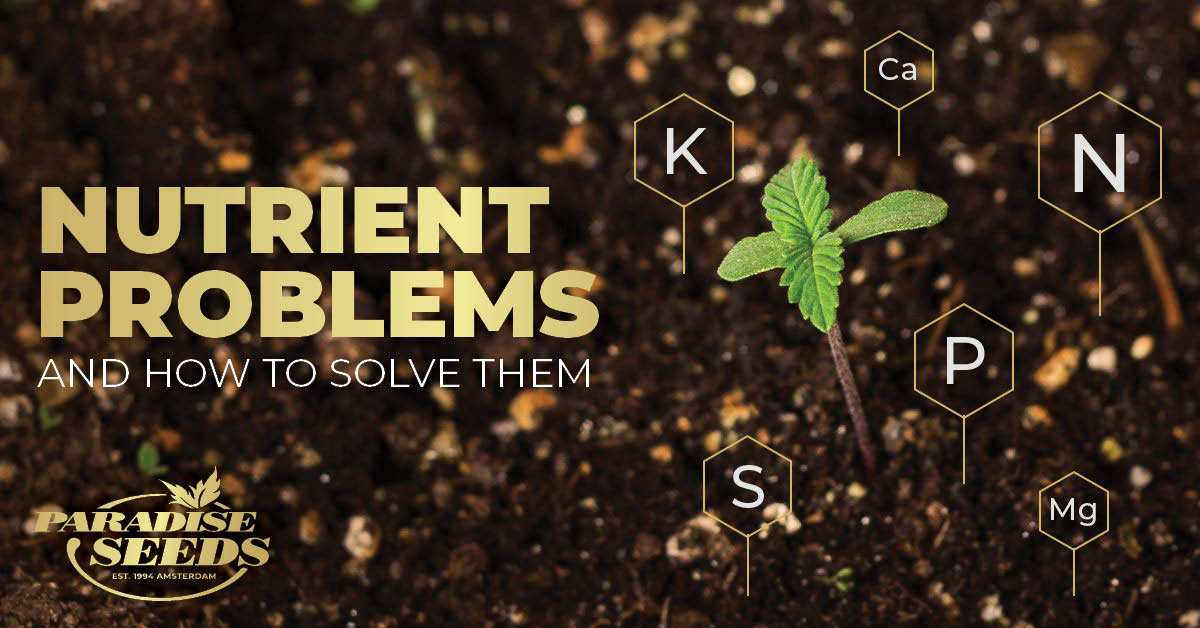Every living organism needs nutrition to survive, develop and thrive and cannabis plants are no different. Therefore, cannabis nutrient management is a topic that appears large on the weed grower’s radar.
Getting the nutrient formula correct means healthy plants and a wealthy harvest from a batch of cannabis seeds! However, getting the nutrient balance wrong can mean unhealthy plants and an underwhelming yield.
This article takes a brief look at the different cannabis nutrients, and the role they play in optimizing a cannabis crop, before taking a look at some of the common problems which can result from a nutrient imbalance.
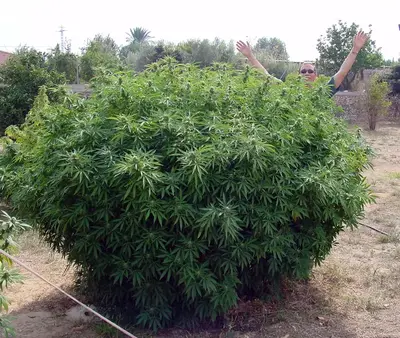
Understanding cannabis nutrients: macronutrients, micronutrients and pH
Primary macronutrients for cannabis plants
Just like most plants, cannabis has specific nutrient requirements to support its growth, and this is provided by the primary macronutrients (which are frequently referred to as NPK):
- Nitrogen (N) plays a vital role in foliage growth, photosynthesis, and overall plant vigor.
- Phosphorus (P) is crucial for root development, flowering, and bud formation.
- Potassium (K) contributes to overall plant health, water regulation, and nutrient transport.
Secondary macronutrients for cannabis plants
Although cannabis plants don’t require as much of these secondary macronutrients as NPK,
they also have an important role to play in the health of weed plants:
- Calcium (Ca) is vital for cell wall development and disease resistance.
- Magnesium (Mg) is a key component of chlorophyll, essential for photosynthesis.
- Sulfur (S) is involved in various enzymatic processes and aids in nitrogen utilization.
Micronutrients for cannabis plants
Micronutrients are essential elements needed in small quantities for optimal cannabis plant growth. These include iron (Fe), zinc (Zn), manganese (Mn), copper (Cu), boron (B), molybdenum (Mo), and others.
Amongst various critical physiological processes, micronutrients’ activity interaction with weed plants includes providing enzyme activation and fuelling hormone production. They are only needed in trace elements, but they are vital for maintaining plant health.
The importance of pH levels on cannabis nutrient absorption
Cannabis plants prefer a slightly acidic to neutral pH range of around 6.0 to 7.0. The pH levels influence nutrient availability and uptake in the growing medium.
Maintaining proper pH levels is essential to ensure optimal nutrient absorption and plant health.
If the pH levels are outside of this range it can interrupt efficient nutrient uptake and lead to deficiencies or toxicities. See below for more information about pH related issues.
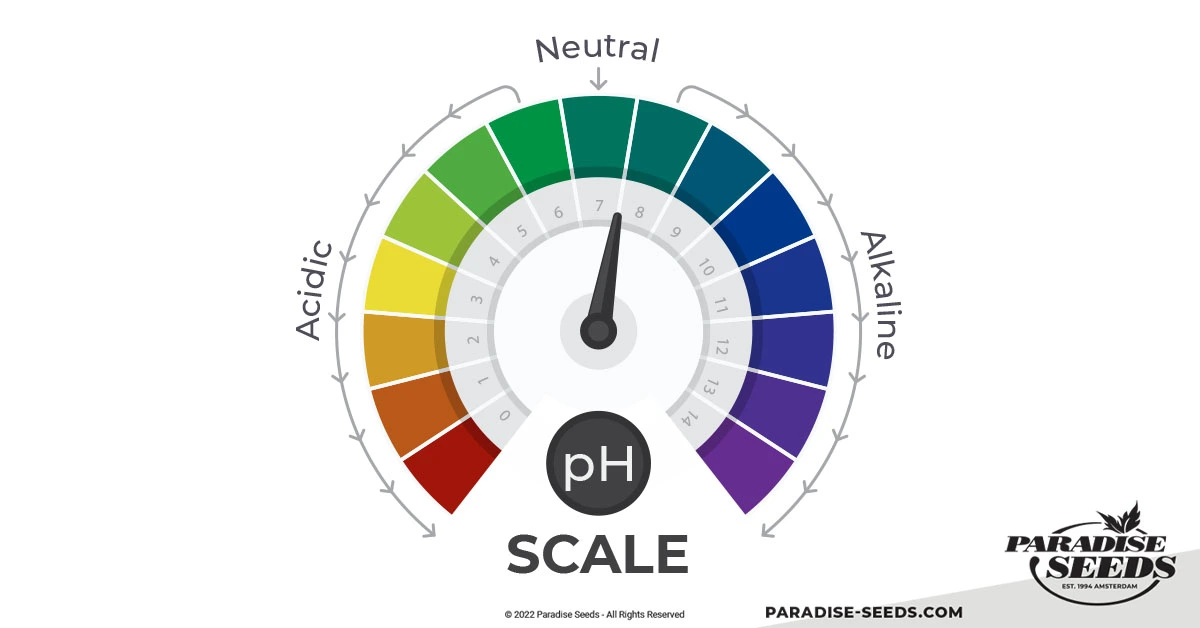
Common nutrient problems: Deficiency and excess
Cannabis nutrient deficiency refers to a condition where a cannabis plant does not receive an adequate supply of the essential nutrients required for it to properly grow and develop.
The bad news for novice weed growers is that it’s sometimes difficult to identify nutrient deficiencies, so here’s our best bit of advice:
- Do your research. Take photos and use them as a reference while searching online, comparing them to images displaying similar symptoms. We always advise joining a grow forum, as the community can help to diagnose the issue.
- Be patient. It’s better to take a little more time to be sure of what deficiency you have rather than rushing in to apply a fix which may end up harming your plants more.
- Plants are pretty resilient, and will bounce back, so you have more time than you think. The important thing is to find the right solution.
These are the most common nutrient issues based on cannabis growers’ experiences.
Nutrient Deficiencies and Their Symptoms
Nitrogen Deficiency
Nitrogen deficiency is characterized by pale or yellowing leaves, starting from the lower part of the plant and progressing upwards. The affected leaves may exhibit slowed growth, reduced size, and a generally weak appearance.

Phosphorus Deficiency
Phosphorus deficiency can cause dark green leaves with a bluish tint, accompanied by a purple discoloration on the stems or undersides of leaves. The plant may display stunted growth, delayed flowering, and poorly developed buds.

Potassium Deficiency
Potassium deficiency typically presents as yellowing or browning leaf edges, starting from the tips and progressing inward. The leaves may become crispy (common with necrosis). Additionally, the plant’s overall vigor and resilience may decline.

Calcium, Magnesium, and Sulfur Deficiencies
Calcium deficiency manifests itself as distorted new growth, with young leaves showing curling or cupping. Magnesium deficiency appears as interveinal yellowing, while sulfur deficiency leads to overall yellowing, similar to nitrogen deficiency.

Micronutrient Deficiencies
Micronutrient deficiencies often result in specific symptoms, which can be more straight forward to diagnose:
- Iron deficiency causes yellowing between the veins, known as interveinal chlorosis.
- Zinc deficiency displays stunted growth and distorted leaf development.
- Manganese deficiency causes yellow or white spots on leaves.
- Copper deficiency leads to wilting and browning of leaf tips.
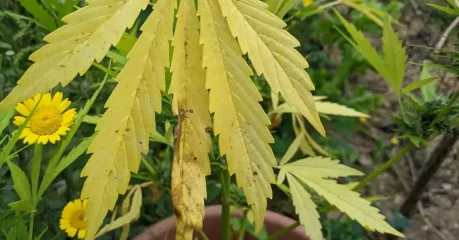
Nutrient excess and its effects
On the flipside, overfeeding cannabis plants with nutrients can cause ‘excess’ issues. A common sign that plants are getting an excess of nutrients is when tips of leaves start to turn yellow and then brown. This is an indicator of ‘nutrient burn’.
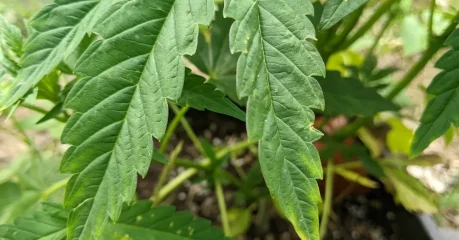
Nitrogen excess
Nitrogen excess can cause dark, lush foliage and vigorous vegetative growth. However, it may lead to delayed flowering, reduced bud development, and increased susceptibility to pests and diseases.
Phosphorus excess
Phosphorus excess can interfere with the uptake of other nutrients, causing deficiencies in micronutrients such as iron and zinc. It may also result in nutrient imbalances, stunted growth, and potential toxicity symptoms.
Potassium excess
Potassium excess can hinder the absorption of other essential nutrients, leading to imbalances. It may result in reduced calcium uptake, affecting cell wall strength and overall plant structure.
‘Excessive’ or imbalanced levels of secondary macronutrients and micronutrients can also lead to nutrient imbalances, affecting plant health and development.
pH-related nutrient issues: Cannabis nutrient lockout
Low pH levels (acidic conditions) can inhibit nutrient availability, leading to nutrient deficiencies. High pH levels (alkaline conditions) can cause cannabis nutrient lockout, where nutrients become unavailable for uptake.
As a basic measure, pH levels below 7 are referred to as ‘acidic’ and pH levels above 7 are referred to as ‘alkaline’.
What causes cannabis nutrient lockout?
Nutrient lockout occurs when pH levels are not within the optimal range, and certain nutrients become chemically ‘bound’ i.e. unavailable for plant absorption.
Common factors contributing to nutrient lockout include improper pH adjustment, too much fertilizer and poor water quality.
Solving nutrient problems in cannabis plants
Diagnosing cannabis nutrient issues
As mentioned before, it’s crucial to diagnose symptoms accurately. A pH test is always recommended at the start of this process.
For the average weed grower (with no access to a lab!), a visual inspection of plants and consulting the internet’s cannabis community for advice on symptoms is the best course of action.
Get the pH balance right to optimize nutrient uptake
If necessary, adjust pH levels using appropriate pH adjustment methods, such as ‘pH up’ or ‘pH down’ products. This process will ensure optimal nutrient availability and absorption.
Nutrient deficiency correction
Nutrient deficiencies can be solved in most cases by adjusting nutrient ratios (i.e. in fertilizers being used) to rebalance the availability of specific nutrients. These may also be supplemented with organic additives to provide additional sources of deficient nutrients.
Nutrient excess correction
This is quite straightforward. Flushing, with clean water, can be employed to leach out excess nutrients. Feeding schedules may then be reduced to prevent nutrient concentrations causing overfertilization.
Best Practices for cannabis nutrient management
Create a balanced nutrient feeding schedule
Consider the nutrient requirements at each of the cannabis grow stages and adjust ratios and concentrations accordingly. We advise using the products of a reputable (organic) fertilizer brand and to follow their recommended feeding schedule. Alternatively, prepare your own slow release fertilizer solutions.

Follow an effective watering schedule
Grow in a well-drained grow medium and avoid overwatering to maintain proper moisture levels. Allow the growing medium to partially dry out between watering sessions to prevent nutrient leaching and oxygen deprivation.
Regular Monitoring and Adjustments
Don’t forget, this is an ongoing process! Get into the routine of regularly monitoring pH and nutrient levels to identify potential issues early and address imbalances immediately. Do this and you should avoid significant issues as a result of nutrient deficiencies and excesses.
Conclusion
These guidelines provide a reliable checklist and a compass to give some direction in regards to what cannabis nutrients are needed and how to diagnose and solve common nutrient issues.
However, this should be your definitive guide when diagnosing nutrient issues as some of these symptoms can also be replicated by other common pests and diseases which afflict cannabis plants. Therefore it is always advisable to research extensively around the problem.
Finally, in the words of Jean-Jacques Rousseau; “Patience is bitter, but its fruit is sweet.” So don’t rush and take your time to diagnose the problem!


